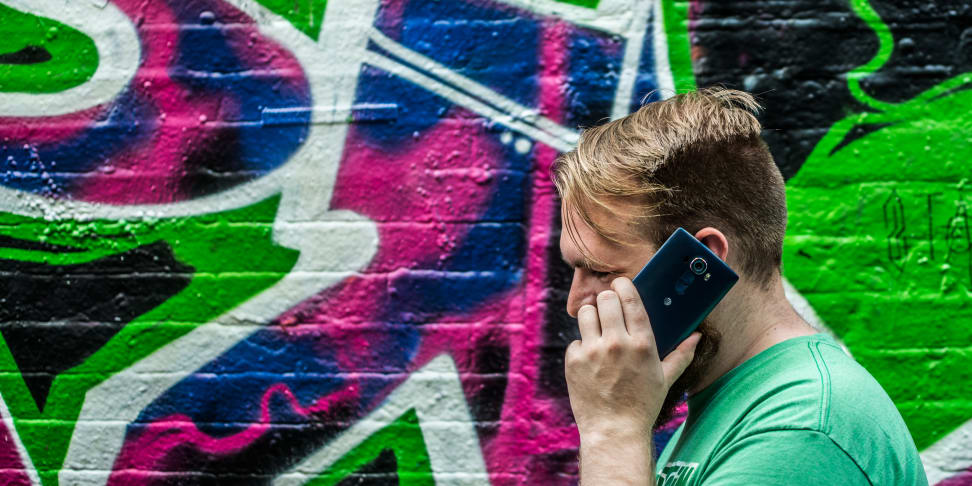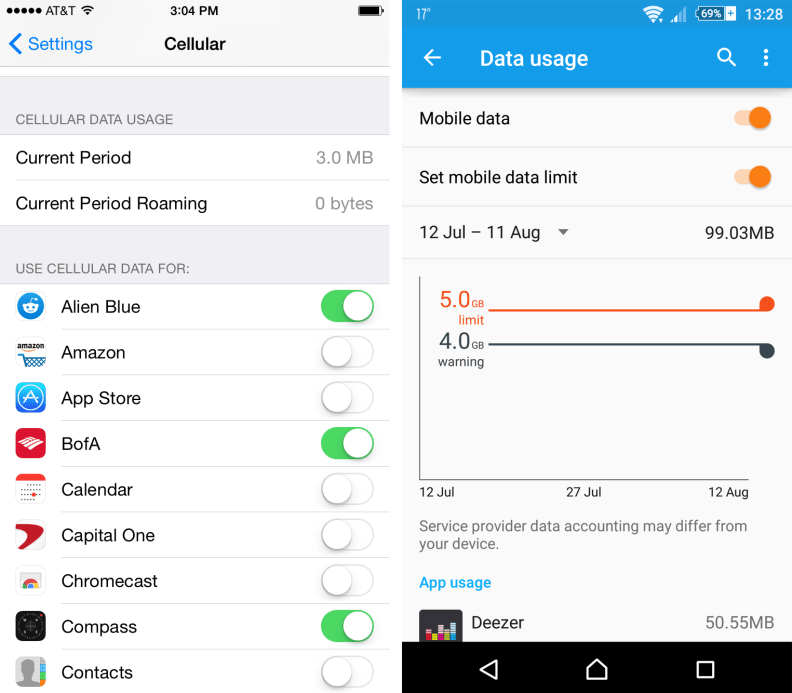 Credit:
Reviewed.com / Chris Thomas
Credit:
Reviewed.com / Chris Thomas
Recommendations are independently chosen by Reviewed's editors. Purchases made through the links below may earn us and our publishing partners a commission.
Data is expensive, and it's often difficult to tell how much money you're throwing down the drain. While it's almost always a better idea to watch that YouTube video using your WiFi rather than your wireless service, how to go about limiting your overall data usage isn't so obvious.
Whether you have an iPhone or Android device, there are a number of steps you can take (and settings you can adjust) to reduce your monthly data usage and prevent unwanted charges. Here is our comprehensive guide to lowering your phone's data usage.
How Are You Using Data?
First thing's first—it's time to get a feel for how you're consuming data. There are a number of ways to do this, but the best method is to visit your phone's cellular data settings.
iOS
Go to Settings > Cellular to review how much data you've used within a given period, as well as any roaming data you might have incurred. If you scroll down you'll find a precise rundown of how much data each one of your apps has consumed over the same period. This should provide a detailed understanding of how you're using your data, and where you could cut back. Take some time to decide which apps you want using cellular data and toggle their respective icons appropriately.
However, you'll need to remember to reset the data rundown from time to time or it won't be particularly useful. It may be helpful to set an alert at the beginning of each billing period to give yourself an idea of how much you're being charged. Simply scroll to the bottom of the Cellular screen and hit Reset Statistics.

Blocking data usage limit with iOS (left) and Android (right)
Android
Pull down your notification bar and tap Settings > Data Usage. (This may be under Connections in some Samsung devices.) Here, you can analyze how much data you've used in the most recent cycle, which you can set monthly. Like with iOS, it will also give a precise rundown of how much data your apps are consuming.
With Android 4.0 and later, you can also set data alerts and limits. Go to Settings > Wireless & Networks > Data usage > Set mobile data limit. The orange and black lines beneath can be used to determine how much data you can consume before receiving an alert (black), and how you can consume at all (orange).
Other Sources
{{ amazon name="Anker 2nd-Gen Astro E5 16750mAh 3A Portable External Battery Charger", asin="B00N2T7U90", align="right" }}
You can also use a data calculator to help further nail down your data spending habits. (AT&T, Verizon, and T-Mobile all offer free data calculators.)
Another good barometer for data use is your battery. Which apps or services are using the most battery? Chances are they are also consuming a good chunk of data.
At the end of the day, it may your wireless carrier that's the real culprit in all this, in which case you should review some of the other data plans that are available to you. Check out our guide to choosing the best data plan for your budget for more details.
WiFi, WiFi, WiFi
When it comes to limiting your data usage, WiFi is your best friend. Use these networks whenever and wherever possible—but only if you trust the WiFi network. Accessing email or bank info through an unfamiliar network is risky, especially when you're traveling, and can end up costing you more than overshooting your data plan ever would.
But it's not enough to simply connect to a trusted WiFi network and hope for the best. You should manually go through all your apps and determine whether or not you want them using cellular data—this will prevent unwanted data usage when you leave a WiFi network but still have some apps running.
Choose Which Apps Have Access to Data
iOS: Go to Settings > Cellular. For each app that you do not want consuming cellular data (ever_), toggle the corresponding button to off. This is especially important for data-intensive apps like Netflix, YouTube, and Spotify.
Android: This is a bit more complicated for Android. While you can control which apps have access to background data, you'll need a third-party app to control which apps are allowed to use cellular data at all. Here are a few: LostNet Firewall, DroidWall, AFWall+.
Update Apps Using WiFi Only
There aren't many reason why you would use cellular data instead of WiFi to update an app, so just go ahead and turn this option off.
iOS: Go to Settings > iTunes & App Store > Use Cellular Data. You can still allow Automatic App Updates, but by turning off the Use Cellular Data option you ensure that those background updates occur over WiFi.
Android: Go to the Google Play store and hit Menu > Settings > Auto-update apps. Make the "Auto-update apps over Wi-Fi only" option is selected. You can also choose to never auto-update apps—just remember to do it manually, if that's the option you select.
Turn Off Background Data
Background Data not only drains your battery, it can consume a good chunk of your data plan without you even realizing it. For that reason, it's one of the more insidious sources of data consumption.

What is Background Data? Background Data is used to process and sync apps like Facebook or email, allowing you to receive updates without having to actually load the program. Its value is somewhat marginal, and in most cases you can do without it. The thing is, though, a lot of devices will have Background Data on as the default setting. Here's how to fix that:
iOS: Go to Settings > General > Background App Refresh. Toggle the button to off, or leave it on and manually sort through which apps you want using background data.
Android: Go to Settings > Wireless & Networks > Data usage, then tap on individual app icons to adjust background data usage options.
Change In-App Settings
From Location Services to Notifications, most apps come with their own host of settings—some of which may consume wireless data. Spend some time looking through the settings for your most commonly used apps to make sure you've deselected the services you have no need for.
{{ amazon name="SanDisk Ultra 64GB microSDXC UHS-I Card", asin="B010Q588D4", align="right" }}
For example, maybe your Foodler app doesn't need to engage Location Services, since you gave the local pizza place your address anyway. Or maybe one of your photo apps automatically backs up new images to the cloud—you need to make sure it's not doing so using cellular data. Here's how to access your app settings:
iOS: Just go to Settings and scroll down to the list of apps that are on your device. You'll find a host of settings within each.
Android: Go to Settings > Apps for a similar list of apps and their corresponding settings.
Preload Data
If you're expecting a lengthy period without WiFi—maybe for a commute or a night out on the town—consider preloading or "caching" data while you're still connected to a WiFi network.
You can use apps like Pocket to save articles or webpages that can then be viewed without any internet connection. Similarly, Spotify, Google Music, and Apple Music all allow you to save playlists that can be accessed offline—just make sure you do the saving part through WiFi. Google Maps also allows you to save entire map regions for offline use.
The truth is, most apps and services offer ways to access important data without an internet connection—you just have to anticipate the demand.
Just Put Your Phone Down
Regardless of how much data you hog, it's probably a good idea to just put your phone down from time to time. It's easy to get caught up with texting and tweeting, but there's a whole world around you just begging for your attention. If you really want to limit your data use, the easiest and most effective way is to simply resist the temptation to check your email every two minutes, put your phone away, and just live.
Related Video
{{brightcove '4825007862001'}}



